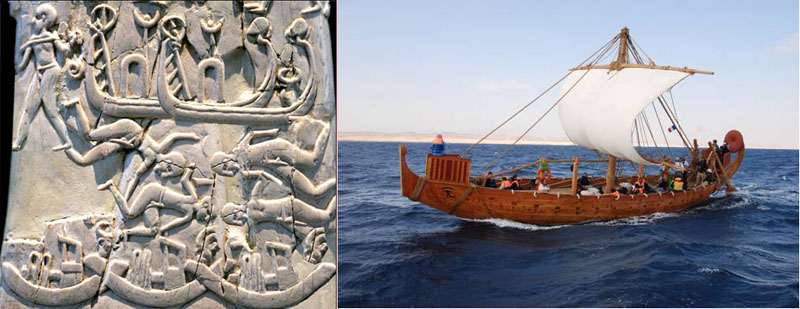
THE KNOWTH - NEWGRANGE - DOWTH OPEN AIR UNIVERSITY OF THE BOYNE RIVER VALLEY, IRELAND
By the latter part of the fourth millennium BC, when the great structures of the Boyne Valley were undergoing construction, maritime trade and the trafficking of valuable cargos on large, sturdy ships, was already well advanced amongst the European and Mediterranean civilisations.

Left: A section of the Gebel el-Arak knife handle, dating to 3500 BC, depicting a naval battle and drowning sailors. Right: A replica Egyptian wooden planked ship from about 1800 BC, authentically constructed according to the known shipwright methods of that ancient epoch, seen here plying the swells of the Red Sea. Ships of similar design carried vast quantities of 99% pure copper ingots from the Great Lakes region of North America to Britain, Continental Europe and the Mediterranean as early as 3000 BC or before.
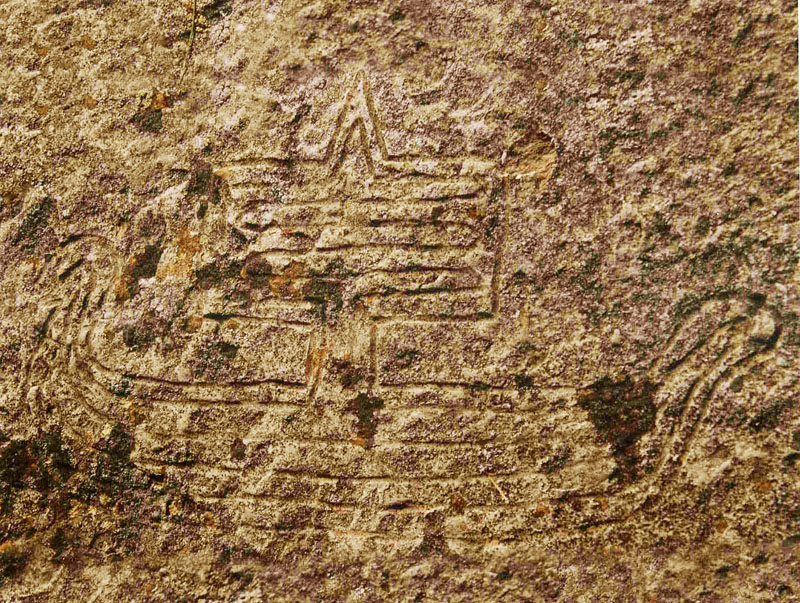
A clearly incised image of the selfsame type of high-prow, square rigged sailing vessel is seen on this rock petroglyph at Copper Harbour, Keweenaw Peninsula, Michigan, USA, which would date to the Bronze Age (most active in circa 2500 BC to about 1100 BC, but with evidence of mining back to 4000 BC and before).
During this period, it was essential to the survival of European-Mediterranean civilisations that they possess bronze, especially for the fabrication of defensive weapons. Estimates on how much copper left North America and crossed the Atlantic to feed the European Bronze Age vary considerably, but one author states:
'The chief ingredient for bronze is copper. The era around 3000 BC saw more than 500,000 tons of copper being mined in the so-called Upper Peninsula, in the American state of Michigan. The largest mine was on Isle Royale, an island in Lake Superior, near the Canadian border. Here, there are thousands of prehistoric copper pits, dug thousands of years ago by ancient peoples unknown. The Mining Belt on Isle Royale has a distance of one and three quarter miles in length and is nearly four hundred feet wide. The copper pits range ten to thirty feet deep with connecting tunnels; one archaeologist estimated that their digging would take the equivalent of 10,000 men working for 1000 years.'
The ancient Irish are renown for possessing vast quantities of gold as well (with about 500 ancient artefacts on display in Irish Museums) and the debate has raged for years as to where they got it. Ancient writings talk of groups like the Tuatha De Danann bringing gold to Ireland during the Neolithic Age.
There is a huge body of evidence to show very vibrant, trans-cultural diffusionism and intermigrations between Egypt and the greater Mediterranean with the British Isles, from remote antiquity and that all the countries encircling the Mediterranean Sea were once populated by long enduring, Caucasoid-European civilisations. When the North African region began to become too arid, large segments of those populations moved into the lush, vast territories of Europe, bringing with them into England, Ireland, Scotland and Wales the totality of their culture and sciences, including their weights, measures and volumes standards, tartans, bagpipes, harps and Gaelic language, etc.,etc.
The oldest mummies of Egypt are of Caucasoid, Europeans.
With the abandonment of Egypt, starting in about 5000 BC, and its slow decline or subjugation by other groups, the only regions where the original mathematical and measurement systems that built the pyramids were preserved was amongst the European nations.
Way mark trails, composed of cairn, standing stones and dolmens were erected all the way across the top of North Africa, from Israel to the Straits of Gibraltar. The way mark trails (for travellers) continued up the coast of Spain, Portugal and France to Scandinavia.
'It is the view of many scholars that the general usage and scientific applications of standing stones or other types of stone landmark monuments, achieved their greatest sophistication in the British Isles, a region known to the ancients as the 'Isles of the West'. What remains of the ancient trails today points the way back to the place from whence peoples of the modern European nations came' (See Palestine, by Major C.R. Conder, R.E., George Philip & Son, 1889, pp. 142-157).
Further evidence of this mass migration out of the Near East / Middle East is found in Pre-Dynastic Egyptian skull types or those of Mesopotamia from 5,000 years ago. These can be matched to types found in 17th Century, London plague pits or Neolithic cist graves in Switzerland (See Races of Europe, by Professor C.S. Coon, Macmillan, N.Y., 1939).
The building of large, sturdy ocean going ships is the simple part of the overall problem when it comes to engaging in maritime trade. The hard or oftimes insurmountable problem is how to convey those ships and their cargoes to far distant ports, then return safely with exotic, locally unavailable products from those far-flung locations.
It is precisely for this reason that the Boyne River Valley assortment of chambered cairns, Dowth Henge and multiples of outlying mound or enclosure, etc., satellite sites were built, with some as far away as 32-miles distant from the centre position at Dowth Henge.
The whole purpose of the Boyne Valley structures and their many hundreds of purpose-built outliers was to teach navigation on land to the brightest and best of the youth until such time as they, as highly-trained and mature navigators, could be entrusted with ships at sea, their crews and precious cargoes.
ORIENTEERING.
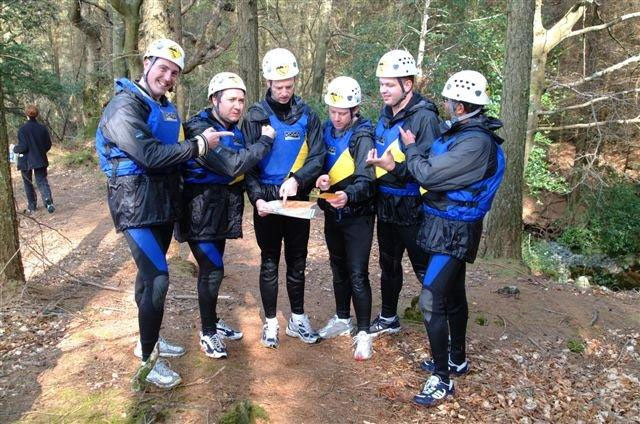
A team of Irish orienteers go over their map prior to
venturing out on a rapid traversal of unknown terrain and (hopefully) arriving
at their distant objective in record time (without getting hopelessly lost).
They're decked-out with all the latest attire, safety helmets (look out
for that low-jutting branch!) and a map of the course, showing prominent
landmarks . On really long and rigorous courses, enduring for a week or so,
the participants enjoy the luxury of a compass, and are usually allowed them
for day-long events as well ... but no g.p.s watches or electronic navigational
aids built into phones, etc.
Whereas modern-day orienteering, outside of military training, was revived as a popular sport in the 19th century it was, obviously, a very serious subject of grueling study during the Megalithic-Neolithic Ages and well into the late Iron Age.
The difference between then and now was, of course, that the ancient orienteers did not have any navigational tracking aids (other than, possibly, a loadstone float, sunstone for determining the position of the sun through cloud or a 360-degree disk device for calculating degree angles). They seemingly had to rely on the rise and set positions of the sun, moon and stars or the ever-changing, calculable angle to landmarks during their overland journey. The tours from objective-to-objective could also span days of concentrated effort, as well as entail covering great distances. Failure to reach much sought-after shelter by dusk could mean a very cold and miserable night out in the elements with wolves, bears and wild boars foraging around them. Success or failure in accurately determining the position of an objective carried with it both rewards or self-punishments, sufficient for a student to not want to repeat a mistake.
The great, sprawling open-air-university of County Meath, Ireland would also have accommodated a vast support network of personnel, waiting at chambered mounds, hamlet enclosures or souterrain shelters, situated far from the Boyne Valley centres, to welcome, feed and offer tutorials to the transient orienteers, before reprovisioning them and launching them onwards to the next objective in the circuit.
Whereas novice or initiate students would, realistically, complete only small circuits until they got the hang of it, the more seasoned apprentices and adepts of the navigational arts would be required to range out from Dowth Henge and the other main centres for 30 miles or more, before circuiting back.
ANCIENT CLUES.
Julius Caesar, who was a very thorough historian, writes the following regarding the late era Druids of his time (circa 55 BC) and tutorials within their many universities in Britain
'They also lecture on the stars in their motion, the magnitude of the Earth and its divisions ...' (see De Ballo Gallico, VII, 15, 16.).
Historian, Isabel Hill Elder further writes,
'The students at these colleges numbered at times sixty thousand of the youth and young nobility of Britain and Gaul. Caesar comments on the fact that the Gauls sent their youth to Britain to be educated .. .It required twenty years to master the complete circle of Druidic knowledge. Natural philosophy, astronomy, mathematics, geometry, medicine, jurisprudence, poetry and oratory were all proposed and taught - natural philosophy and astronomy with severe exactitude' (Elder refers to Strabo I IV, page 197. Caesars Comm. Lib V. Sueotonius, V Calegula. E. Campion, Accounts of Ireland, pg. 18.).
So, what was the primary reason behind teaching about, the stars in their motion, the magnitude of the Earth and its divisions; astronomy, mathematics, geometry; and astronomy with severe exactitude? ... the answer is NAVIGATION.
THE ANCIENT STRUCTURES OF COUNTY MEATH, IRELAND.
The so-called chambered tombs of the Boyne River Valley, County Meath, Ireland were never conceived and built as tombs originally, but obviously as dormitories and hostels for students of navigation and the cyclic-astronomical arts. Only many centuries after the abandonment of the huge, sprawling, overland school were the accommodation structures found to be convenient repositories for cadavers, and a few bodies ended up in the former dormitories. By this occurrence of some human remains being found therein in more modern times, along with animal bones in the internal chambers, the unfortunate concept of a "necropolis" was hatched by our archaeologists as their explanation as to why the huge, laboriously built chambered cairns were erected in the first place.
Nothing could be further from the truth!
Let's explore how the many carefully placed chambered mounds, barrows, henges, ring forts, standing obelisks, souterrains and pond barrows worked in teaching navigation to generations of students.
THE MEASUREMENT STANDARDS
Although by mediaeval times the ages-old weights, measures and volume standards of the formerly great civilisations of the Mediterranean & Europe had drifted slightly away from their earlier precision, at much earlier times they were in perfect synchronicity, nation-by-trading-nation.
All of the cousin civilisations surrounding the Mediterranean or across the expanse of Continental Europe, ranging between Northern India - Persia - Egypt to the British Isles, used exactly the same inch increment in all of their feet or cubits. All of these smaller increments of length were in perfect ratio to their much larger overland measurements of miles or leagues, as used within an individual nation, or within the measurement standards of other cousin nations.
For example, we know absolutely that the very late era Greeks had a foot of exactly 12.6", a short stadia of 525', a long stadia of 630' and a mile of 5250' (5000 Greek feet). In this line-up they also used a perfectly ratioed measurement of 10.5', which the much earlier Hebrews had called a "reed" (126").
We also know that the very late era Romans had a foot of 11.664" (11 & 83/125ths feet), a pace of 5 Roman feet (58.32") and a mile of 5000 Roman feet.
'The Roman foot was found to be 11.664 inches by John Greaves, professor of geometry, who in 1639 went to Rome specifically to ascertain the length of an ancient Roman foot. Greaves located a monument of Roman architect, Stalius Asper and measured bas relief instruments used by him in the first century A. D. Greaves concluded, after careful investigation, that the Roman foot, 'contained 1944 such parts as the English foot contains 2000'. This means a Roman foot of 11.664 inches*. (See: Ancient Metrology, by Donald Lee Lenzen, published in 1989).
A piece of history that was preserved and handed down into mediaeval times was that 75 Roman miles equalled 1-degree of equatorial arc for the world. This system is but one of at least 4 major navigational systems that could be used, as Julius Caesar put it, to mathematically grid : 'the magnitude of the Earth and its divisions'.
This selfsame, so-called "Roman" measurement standard was being used by the ancient people of Sweden before the rise of the Roman empire, as an in-depth probe of their earliest measurement standards would show. See: http://www.celticnz.co.nz/VikingNavigation.htm
*Footnote: Whereas the Roman mile was 4860', based upon 5000 Roman feet of 11.664", it's very plausible to assume that the very simple measurement of 11.6666" (11 & 2/3rds inches) would have been used for overland marching, etc.).
Both the Greeks and the Romans adopted the weights, measures and volumes standards of much earlier civilisation and, the deeper one looks, the more evident it becomes that the earliest civilisations were using and teaching ALL of the various methods of navigation, altogether.
For example, across the entirety of the British Isles at the great open-air-universities of Avebury, Durrington Walls, Brodgar, etc., we can positively show that there were miles marked into the landscapes of 5940', 5280', 5250' & 4860'. Each of these miles and variable nautical miles derived from them, provided the means to do accurate positional plotting (dead reckoning) at sea.
This same attribute holds true for the Boyne River Valley, Meath, Ireland open-air-university, which was fully operational in teaching navigation and cyclic astronomy by (circa) 3000 BC.
Also, all ancient weights, measures & volume standards, used and shared by the ancient cousin nations were based upon fully factorable numbers and there were no arbitrary standards that were not a part of a mathematical progression.
At the same time, standards could be based upon progressions within a particular number family (like "11" ...the 5940' & 5280' miles ... or "6&7" ...the 5250' mile). See: http://www.celticnz.co.nz/Weights_Measures_Volumes/Weights_Measures.htm
THE BOYNE VALLEY OUTER MARKER FOR DUE NORTH
Firstly, in a surveying sense the Boyne River Valley complex of structures had to be tied to a prominent, visible and permanent geological feature on the horizon, which gave a very precise fix onto one of the primary points of the compass.
The chosen outer marker for this purpose was the high mount called Slieve Gullion, 29-miles North in County Armagh.
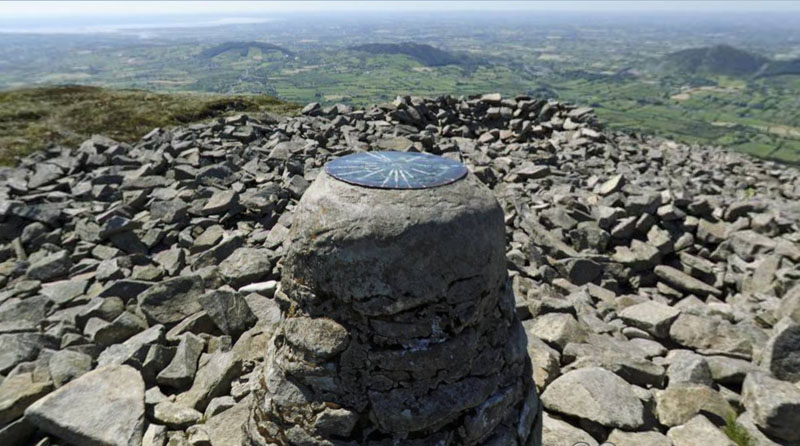
From atop Slieve Gullion Mountain one can reportedly
see southwards all the way to Dublin, almost 60-miles away. The distance
to the Boyne River Valley structures is about half that with, seemingly,
no interim hills high enough to obscure the view back to Slieve Gullion.
Photo courtesy of Howard Goldbaum. See: http://www.voicesfromthedawn.com/wp-content/sites/slieveGullion/combined/indexTablet.html
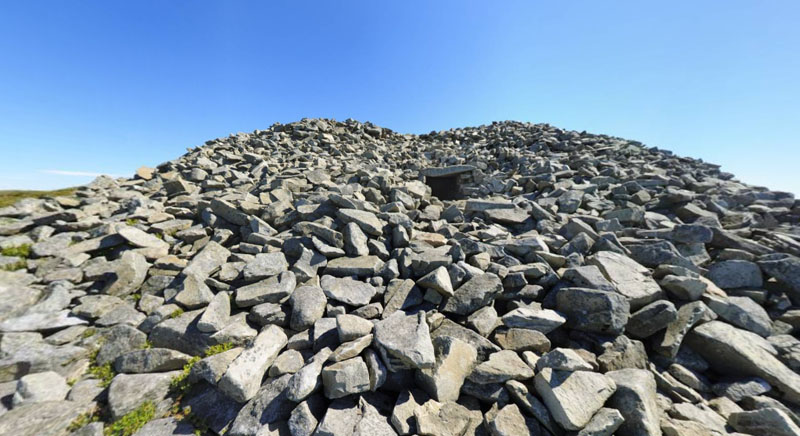
Atop Slieve Gullion Mountain is a chambered cairn called Calliagh Berras House, which would have offered welcome shelter out of the wind and cold for ancient visitors to this high trig, surveying or benchmark position. It is now considered to have been a passage tomb, which indignity it might well have suffered at some later, less enlightened era , although first built for the living and not the dead.
The ancient trig itself was deliberately built out of a wide expanse of very light coloured stone from the lower part of the mountain,which would contrast very vividly with the dark volcanic stone at the summit. This wide expanse, topped by a passage cairn hump at the highest point, acted as a conspicuous patch-maker of highly visible material which, on a clear day, could, undoubtedly, be seen from the distant Boyne River Valley in County Meath by individuals with keen eyesight.
SO WHAT SITS DUE SOUTH IN THE BOYNE RIVER VALLEY?
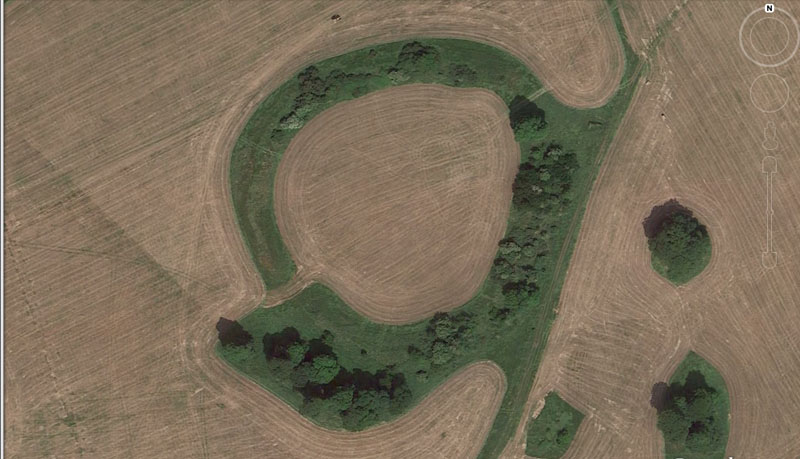
The central area of huge Dowth Henge in the Boyne River Valley, one of the largest henge structures in Ireland, sits due South of the chambered cairn atop Slieve Gullion Mountain. In other words, anyone using the henge for surveying or astronomical observations had a precisely placed and permanent outer-marker designating true North.
Henge sites were extremely important for teaching the kind of astronomy that a navigator would need to know implicitly when sailing across the featureless oceans of the world. The circuiting henge embankment represented an artificial horizon for observers at the centre, over which stars would rise and set. Stars situated in the North could be observed to swirl, in other words to dip down, then go up again. By concentrated observation over several years, star, planetary, lunar and solar movements throughout the entire year would be memorised and methods were taught on how to use this overhead star-map for orientation at sea.
By knowing the precise position of due North, the ever-changing rise and set positions for any celestial object ascending from or alighting upon the henge banks throughout the calendar year could be known, memorised or calculated with exactitude.
This attribute of fixing the centre position of a henge onto a due North high hill or mountain is shared by Durrington Walls Henge in Southern England, which used the Barbury Castle Hill crown on the high Ridgeway for its due North outer-marker (20.2-miles distant centre-to-centre).
Likewise, Avebury Henge used that self-same outer marker, 4.9-miles away, to indicate the azimuth angle position of 36-degrees.
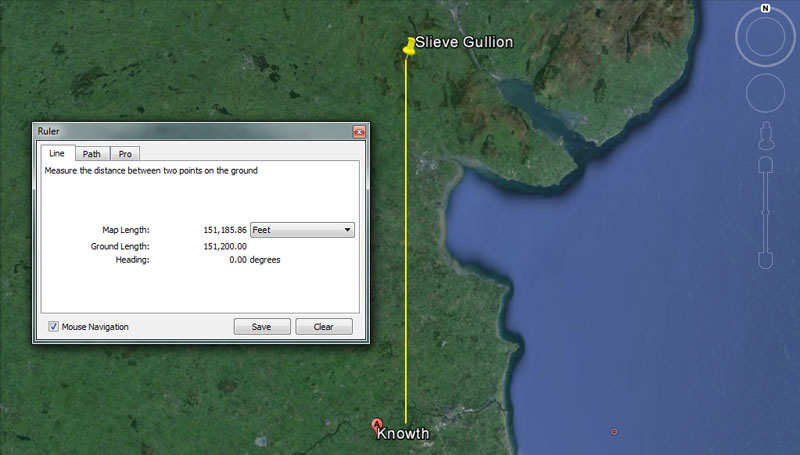
The exact, ancient placement of Dowth Henge, sitting about 2.4 miles ENE of Knowth chambered cairn, was determined by the peak position of Slieve Gullion Mountain in County Armagh, about 29-miles due North. This gave tutors and their students at the henge centre a permanent North-marker on the horizon to refer to when calculating the angles of star, planetary, lunar and solar rises and sets on the circuiting henge embankment.
Of course, with the frequent rains and mists the mountain was only rarely visible in clear weather, so a marker post would, undoubtedly, have been erected on the outer henge bank to indicate due North from the post or stone-marked observer's position in the centre of the henge. By this means, the henge could be used as a training ground, day or night, throughout the entire year, whenever the sky was clear enough to observe celestial targets.